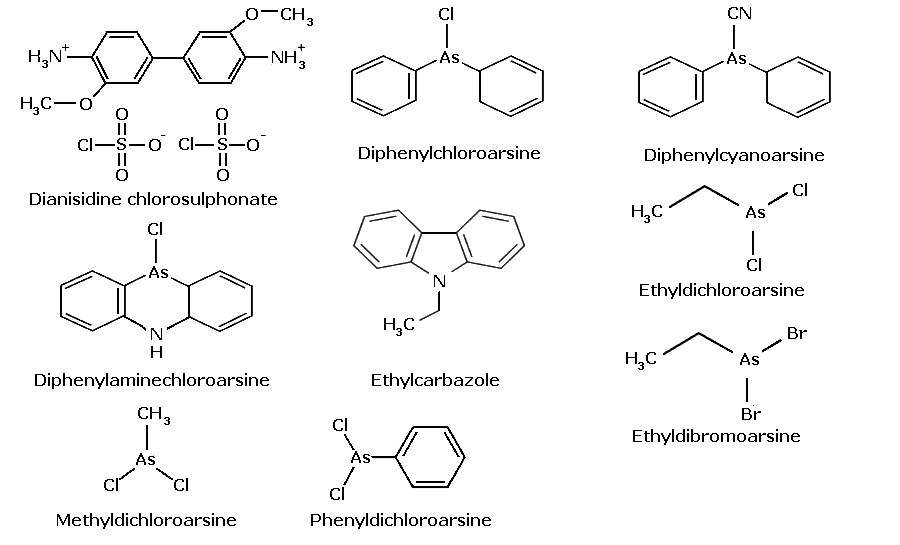Sternutators
Sternutators cause vomiting, respiratory irritation and sneezing, their purpose is to incapacitate rather than to kill the enemy, as such they are sometimes regarded as riot control agents rather than as CW agents. The effects of these agents is short-lived.Dianisidine
chlorosulphonate [Niespulver] - C14H16N2O2ClSO3 -
A colorless or white solid. This agent
is regarded as not very effective, until about 1940 it was still the
major ingredient of joke sneezing powder, in some parts of the
world, but was banned as early as 1919 in the USA.
Diphenylchloroarsine [Chlorodiphenylarsine,
Blue cross, Sternite, DA, Clark I] - (C6H5)2AsCl
-
A colorless crystalline solid, or a dark-brown liquid. Strongly irritating to skin and eyes. Toxic by ingestion and inhalation.
Diphenylcyanoarsine [Sternite,
DC, CDA, Clark II, Chlor-Arsen-Kampfstoff 2] - (C6H5)2AsCN
-
A colorless liquid, odourless or fruity odour. Causes nausea, vomiting and headaches. It can subsequently lead to pulmonary oedema.
Diphenylaminechloroarsine [10-Chloro-5,10-dihydrophenarsazine,
DM, Adamsite] - (C6H4)2NHAsCl -
An odourless crystalline compound with a very low vapour pressure. The colour of the crystals ranges from bright yellow to dark green depending on the purity. It is readily soluble in some organic solvents (e.g., acetone, dichloromethane), but nearly insoluble in water. In vapour form it appears as a canary yellow smoke. Usually dispersed as an aerosol, making the upper respiratory tract the primary site of action. Although the effects are similar to those caused by typical riot control agents (e.g. CS), they are slower in onset but longer in duration, often lasting for 12 or more hours. After a latency period of 5-10 minutes irritation of the eyes, lungs and mucous membranes develops followed by headache, nausea and persistent vomiting.
Ethylcarbazole [N-ethylcarbazole,
9-Ethylcarbazole, 9-Ethyl-9H-carbazole] - (C6H4)2NC2H5
-
A brown solid. Causes eye, skin, respiratory and digestive tract irritation.
Ethyldibromoarsine -
C2H5AsBr2 -
This colourless volatile liquid, reportedly smells like rotting fruit. Vapours irritate eyes and skin. Very toxic by inhalation. Denser than water and vapours are heavier than air.
Ethyldichloroarsine [Dick,
EDED, TL-214; Dichloroethylarsine, Ethyldichloroarsine,
dichloro(ethyl)arsane, Ethylarsenic dichloride, Ethylarsonous
dichloride] - C2H5AsCl2 -
This colourless volatile liquid, reportedly smells like rotting fruit. Vapours irritate eyes and skin. Very toxic by inhalation. Denser than water and vapours are heavier than air.
Methyldichloroarsine [Methyldick,
MD] - CH3AsCl2 -
This colourless volatile liquid is a highly toxic vesicant. Symptoms resemble those from poison ivy, other symptoms include irritation to the eyes and to the nose, although blistering may be delayed for hours. Other symptoms include: dermal burns with vesicle formation; blepharospasm and photophobia. Convulsions, abdominal pain, coughing, and shortness of breath with damage to the respiratory system can be delayed for about three to five days; haemolysis can also occur.
Phenyldichloroarsine [Sternite]
- C6H5AsCl2 -
An odorless, colourless to brownish liquid with an oily texture which damages the eyes, lungs, throat and nasal membranes. It also induces nausea and vomiting. Long-term exposure to phenyldichloroarsine can cause systemic damage by replacing calcium with arsenic, extensive bone marrow damage can also result. Due to phenyldichloroarsine being easily recognized in the field and a relatively fast rate for decontamination procedures to become effective, the chemical is not as useful as other blister agents. The blistering resultant from phenyldichloroarsine exposure may also be delayed, for as little as 30 minutes, or as long as 32 hours depending upon the concentration of the dose.

